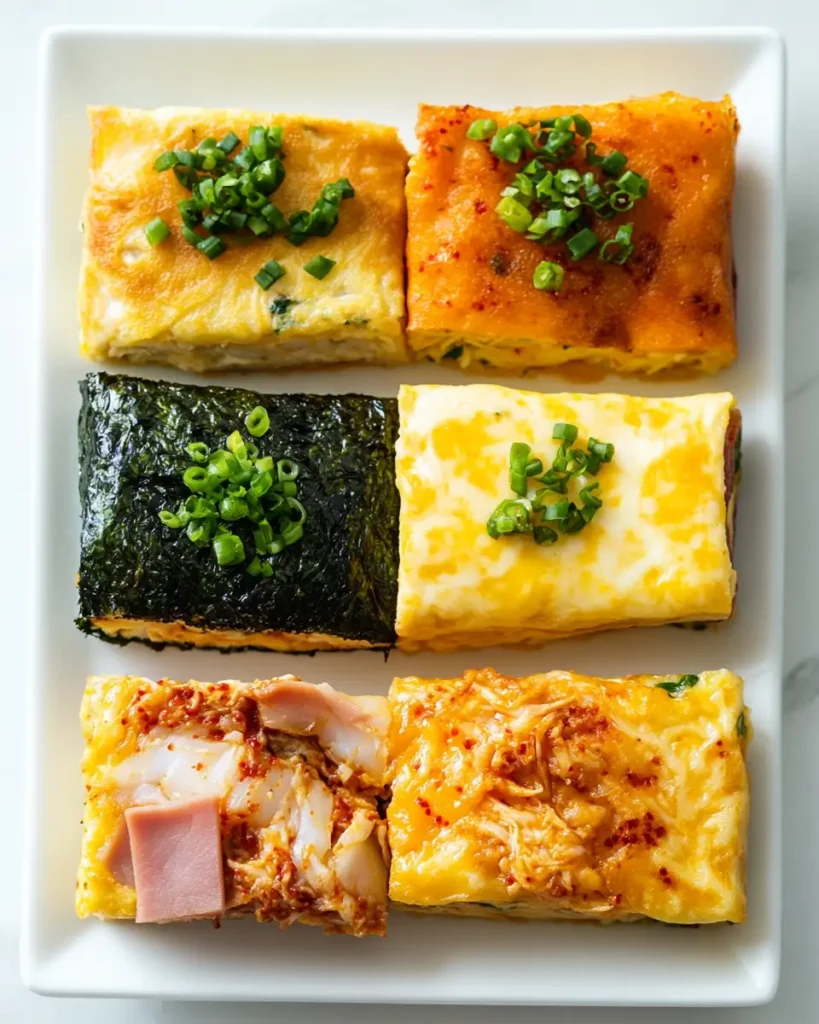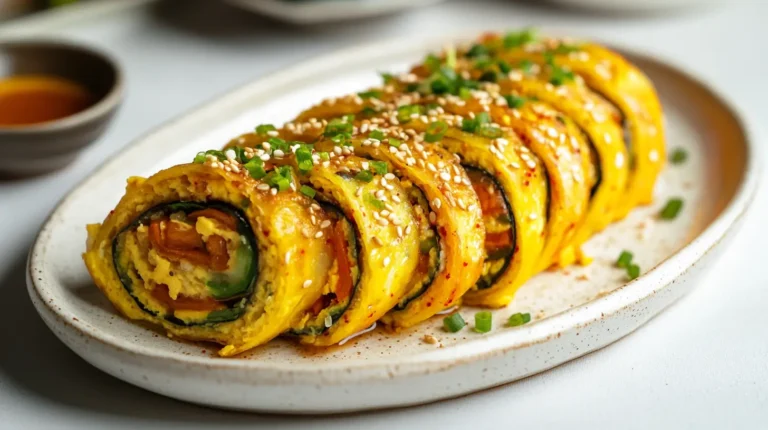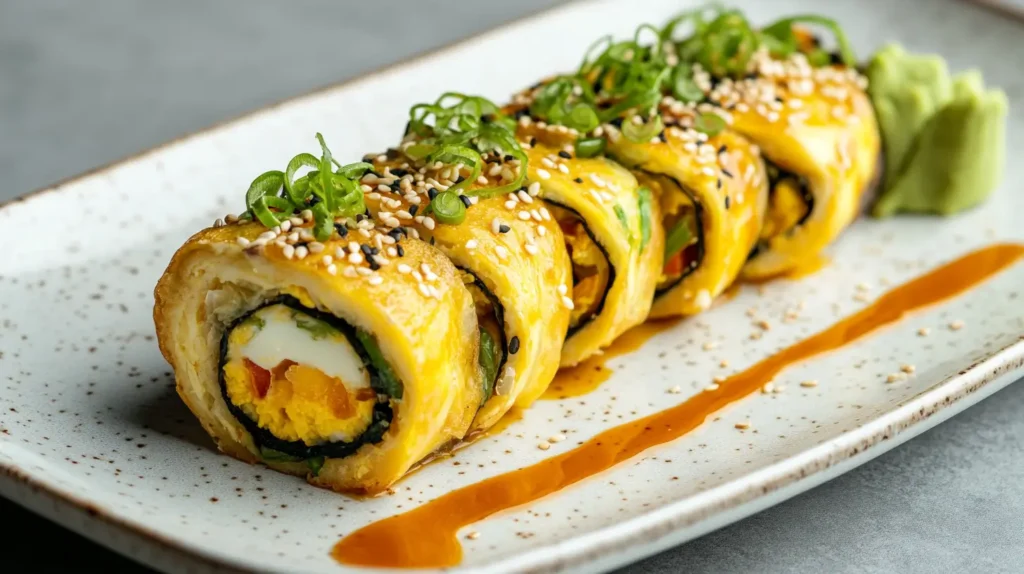Introduction to Korean Gyeran Mari (Rolled Omelette)
Tired of boring scrambled eggs or plain sunny-side-ups? It’s time to brighten up your breakfast or lunch with the colorful and savory Korean Gyeran Mari (Rolled Omelette). This rolled egg dish is a staple in Korean households, often seen in dosirak (Korean lunchboxes) and served as a popular side dish (banchan) in both home and restaurant meals.
Visually, it’s a treat—neatly sliced rolls with layers of golden egg wrapped around vibrant veggies and delicious fillings. But beyond the aesthetics, the flavor is comforting, wholesome, and flexible enough to match your cravings. Whether you fill it with ham, cheese, seaweed, or keep it simple with green onions, the dish adapts beautifully.
If you love easy egg recipes that don’t skimp on flavor—like the Effortless Veggie Omelette Roll—this Korean twist will quickly become a favorite. It’s also great for meal prepping, fitting nicely into lunchboxes or quick breakfasts without losing its flavor or texture.
Korean Gyeran Mari (Rolled Omelette) is more than just an omelette—it’s a fun, quick dish that adds warmth and creativity to your daily meals.
What is Korean Gyeran Mari (Rolled Omelette)?
At its heart, Korean Gyeran Mari (Rolled Omelette) is a rolled omelette made with eggs, chopped vegetables, and optional fillings like ham or cheese. Unlike your average folded Western omelette, it’s cooked in thin layers, each one gently rolled over the last until you have a thick log of eggy goodness. After cooling for a moment, it’s sliced into spiral-patterned pieces that are as beautiful as they are tasty.
The magic lies in the technique—careful layering and rolling while maintaining a soft texture. It’s traditionally cooked over low to medium heat to ensure that each layer is tender, not rubbery, and doesn’t brown too much. The final result is clean, smooth, and packed with flavor in every bite.
This dish stands apart from other baked or skillet egg dishes like the Cornbread Breakfast Casserole, offering a lighter and more structured presentation. It’s perfect as a breakfast item, a quick side dish, or even as a protein-packed snack throughout the day.
Whether you’re new to Korean cuisine or a fan already, Korean Gyeran Mari (Rolled Omelette) is an accessible and rewarding recipe to try at home.
The History of Korean Gyeran Mari (Rolled Omelette)

The roots of Korean Gyeran Mari (Rolled Omelette) are grounded in traditional Korean home cooking, where the emphasis is on practicality, minimalism, and flavor. This dish became a beloved staple not because of fancy ingredients but because of its simplicity and adaptability. Korean mothers have long used it as a quick protein dish for their children’s lunchboxes, often customizing it with whatever leftovers were on hand.
Its widespread popularity grew with the boom of K-dramas and Korean cooking shows, where beautifully sliced gyeran mari became a regular sight on dinner tables and picnic mats. It’s often presented in family meals, school lunches, and even formal gatherings as a humble but elegant side.
The appeal of Korean Gyeran Mari (Rolled Omelette) is similar to cozy classics like the Hashbrown Casserole, which are not only comforting but also versatile and nostalgic. This egg roll represents the soul of Korean cuisine—simple ingredients used in creative, delicious ways.
It’s more than just an egg roll. It’s a cultural comfort food passed down through generations, connecting tradition with everyday cooking.
Why You’ll Love Korean Gyeran Mari (Rolled Omelette)
There’s a reason why Korean Gyeran Mari (Rolled Omelette) is beloved both in Korea and around the world—it checks all the right boxes. It’s fast to make, healthy, visually impressive, and endlessly customizable.
You can prepare it in under 20 minutes, using just a handful of pantry staples: eggs, a pinch of salt, a drizzle of oil, and whatever chopped vegetables or proteins you prefer. It’s also a fantastic way to repurpose leftovers like ham or bell peppers, reducing waste while creating a new, flavorful dish.
For those who love elegant brunch recipes, the refined simplicity of Korean Gyeran Mari (Rolled Omelette) is on par with dishes like Smoked Salmon and Avocado Eggs Royale. It can be a side dish, a snack, or the star of your meal—it all depends on how you serve it.
Kids love it, adults appreciate its clean taste, and home cooks love how adaptable it is. From weekday breakfasts to weekend brunch spreads, Korean Gyeran Mari (Rolled Omelette) adds both beauty and nutrition to your table.
Step-by-Step Guide to Making Korean Gyeran Mari (Rolled Omelette)
Making Korean Gyeran Mari (Rolled Omelette) is simple, quick, and fun—even for beginners. With just a few basic ingredients like eggs, finely chopped veggies, and a dash of seasoning, you can create a soft, rolled omelette that’s perfect for any meal.
The technique involves pouring thin layers of egg into a heated non-stick pan, gently rolling each one as it cooks. As you repeat the process, a beautiful spiral forms that holds all your flavorful fillings. Once it’s done, a short rest helps it set before slicing into thick, satisfying pieces.
It’s a process that requires a bit of patience and care, much like layering ingredients in a dish such as the Layered Beef Mince and Potato Gratin. But the result is always worth it.
📌 CLICK HERE 📌 to view the full printable recipe with detailed measurements and step-by-step instructions in the recipe card plugin.
Creative Variations of Korean Gyeran Mari (Rolled Omelette)

One of the most delightful things about Korean Gyeran Mari (Rolled Omelette) is its versatility. While the traditional version with just green onions is delicious, adding fillings takes it to a whole new level. Whether you prefer savory, spicy, or seafood flavors, there’s something for everyone.
Here are the best 4 fillings to try:
1. Ham and Cheese
A timeless combo that’s especially popular with kids. The cheese melts beautifully into the egg layers, creating a gooey, rich texture, while the ham adds a salty, meaty bite that balances the dish.
2. Seaweed (Gim)
For a more traditional Korean twist, lay a thin sheet of roasted seaweed inside the omelette before rolling. It adds a burst of umami and looks striking when sliced into spirals.
3. Kimchi
Chopped kimchi introduces a bold, tangy flavor and a bit of spice, offering a more intense, adult version of the dish. Just be sure to squeeze out excess liquid to prevent sogginess.
4. Crab Sticks (Surimi)
If you love seafood, imitation crab sticks are a quick and tasty option. They pair perfectly with eggs and lend a subtle oceanic flavor that’s not overpowering.
Just like bold recipes such as the Louisiana Voodoo Fries, these fillings transform a simple egg dish into something unforgettable.
How to Store and Serve Korean Gyeran Mari (Rolled Omelette)
Meal prep fans, rejoice—Korean Gyeran Mari (Rolled Omelette) stores and reheats like a dream. Once cooked, it holds its texture well, making it ideal for next-day lunches or quick snacks.
Here’s how to keep it fresh and tasty:
Let it cool completely before storing. Warm or steamy rolls in a sealed container can cause condensation, which leads to sogginess.
Use an airtight container and store in the refrigerator for up to 3 days.
Reheat gently: Microwave on medium power for 20–30 seconds or warm it up in a pan over low heat for better texture.
When it comes to serving, this dish shines as part of a Korean-style meal with rice, kimchi, and soup. It also makes a lovely addition to brunch platters or lunchboxes. For a heartier pairing, serve it alongside a protein dish like Creamy Mushroom and Spinach Stuffed Chicken. The contrast between the creamy, rich chicken and the light, savory egg roll is perfect.
Whether you’re enjoying it warm or cold, Korean Gyeran Mari (Rolled Omelette) is as practical as it is delicious.
Tips for the Perfect Korean Gyeran Mari (Rolled Omelette)
Getting that beautiful spiral in your Korean Gyeran Mari (Rolled Omelette) takes just a bit of practice—and a few pro tips. Follow these pointers for consistently great results:
Cook low and slow: High heat causes eggs to brown and toughen. Stick to medium-low heat for a soft, tender roll.
Finely chop your ingredients: Large chunks make the roll uneven and hard to manage. Keep everything small and uniform.
Use a non-stick or well-oiled pan: This is crucial for clean rolling. You don’t want your layers sticking and tearing midway.
Tilt the pan to spread the egg: This ensures even cooking and thin, rollable layers.
Season at the right time: Add salt to the eggs before cooking, so the flavor distributes evenly.
Also, a soft spatula or chopsticks can make rolling smoother, especially as the layers build up. And don’t rush! Let each layer firm up slightly before rolling, but not so long that it browns or cracks.
This level of care is similar to what you’d apply to delicate dishes like the Effortless Veggie Omelette Roll—where patience and detail pay off in every bite.
Common Mistakes to Avoid When Making Korean Gyeran Mari (Rolled Omelette)
Even though Korean Gyeran Mari (Rolled Omelette) looks straightforward, a few small errors can lead to disappointing results. Here are the most common pitfalls to avoid:
Overfilling: It’s tempting to stuff it full of cheese or meat, but too much can prevent clean rolling and cause the omelette to fall apart.
Pouring too much egg at once: This makes the layer thick and hard to roll. Thin layers are key to getting that iconic spiral.
Using cold eggs: Always let your eggs come to room temperature. Cold eggs don’t whisk or cook evenly.
Not greasing the pan properly: A sticky surface will tear the delicate egg sheets, ruining the roll.
Overcooking: Cook just until set. Overdone eggs turn rubbery and dry.
Patience and precision matter with Korean Gyeran Mari (Rolled Omelette), just like when baking layered breakfast casseroles such as the Cornbread Breakfast Casserole. Follow the technique and avoid shortcuts to enjoy a perfect roll every time.
Decorating Ideas for Korean Gyeran Mari (Rolled Omelette)

Although it’s made with simple ingredients, Korean Gyeran Mari (Rolled Omelette) can be transformed into a visually stunning dish with just a few creative touches. Its neat, spiral-shaped slices are already eye-catching, but adding decorative elements can make it look restaurant-worthy, especially if you’re serving guests or packing a fancy lunchbox.
Here are some easy yet elegant ways to elevate the presentation:
Garnish with toasted sesame seeds or freshly chopped chives on top for a pop of texture and color.
Drizzle a light soy-sesame dipping sauce in a small dish beside the rolls. This not only adds flavor but also enhances the plating aesthetic.
Use vibrant veggies like red bell peppers, purple cabbage, or zucchini in your egg mix to create a rainbow effect in each slice.
Slice with care: Use a sharp knife and wipe it between cuts to maintain clean, precise edges.
Serve on a bamboo tray or dark ceramic plate to highlight the golden egg and colorful filling.
Add a side of pickled radish or kimchi for contrast and balance.
Much like other layered dishes such as the Hashbrown Casserole, great plating brings out the charm and appeal of the dish. A thoughtfully arranged Korean Gyeran Mari (Rolled Omelette) can turn a simple side into a showstopper.
FAQs About Korean Gyeran Mari (Rolled Omelette)
Curious about the finer details of making Korean Gyeran Mari (Rolled Omelette)? Here are some of the most frequently asked questions to help guide you:
Q: Can I use egg whites only?
Yes, egg whites can be used, especially if you’re watching cholesterol. However, the texture may be slightly firmer and less rich compared to using whole eggs.
Q: What kind of fillings are best for kids?
Kids usually love mild, familiar flavors like cheddar cheese, thinly sliced ham, or finely chopped carrots and zucchini. You can also sneak in a few greens for extra nutrition.
Q: Do I need a rectangular pan to make it?
A rectangular pan gives that clean, even roll—but it’s not required. A small, round non-stick skillet will also work; just adjust your rolling technique slightly.
Q: Can I freeze Korean Gyeran Mari (Rolled Omelette)?
It’s not recommended. Freezing alters the texture, making it rubbery and watery when reheated. It’s best enjoyed fresh or within a few days refrigerated.
Q: Is this dish gluten-free?
Yes, as long as your ingredients—especially soy sauce and fillings—are labeled gluten-free. Always double-check your condiments and processed items.
If you love versatile, make-ahead dishes like the Layered Beef Mince and Potato Gratin, you’ll appreciate how customizable and quick this rolled omelette can be.
Conclusion
Korean Gyeran Mari (Rolled Omelette) is more than just a rolled egg—it’s a celebration of simplicity, creativity, and flavor. From quick weekday breakfasts to elegant brunch spreads, this dish brings charm, versatility, and satisfaction to any table. With just a few basic ingredients and a non-stick pan, you can whip up something that looks beautiful, tastes incredible, and pleases everyone from kids to adults.
Whether you go with the classic green onion version or explore bold fillings like kimchi, crab sticks, or seaweed, the possibilities are endless. Best of all, it’s budget-friendly, quick to prepare, and pairs wonderfully with rice, soups, and other Korean banchan favorites.
If you’ve enjoyed elegant brunch options like Smoked Salmon and Avocado Eggs Royale, you’ll find that this Korean-style omelette brings that same level of sophistication with much less effort. And for those looking to expand their egg recipe repertoire, check out globally inspired ideas from trusted sites like AllRecipes, NYT Cooking, and Tasty—each offers a wealth of techniques and flavor combinations worth exploring.
Happy rolling—and don’t forget to have fun with your fillings!
Print
Korean Gyeran Mari (Rolled Omelette): Best 4 Fillings to Use
Korean Gyeran Mari (Rolled Omelette) is a popular Korean side dish made by layering and rolling beaten eggs with vegetables or fillings like cheese, ham, seaweed, or kimchi. It’s simple to prepare, visually appealing, and perfect for breakfast, lunchboxes, or a light side dish with rice.
- Total Time: 15 minutes
- Yield: 2 servings 1x
Ingredients
4 large eggs
2 tablespoons finely chopped green onions
1 tablespoon finely chopped carrots
Salt, to taste
Black pepper, to taste
1 teaspoon vegetable oil (or sesame oil)
Optional Fillings (choose up to 2):
2 tablespoons shredded cheese
2 tablespoons finely diced ham
1 sheet roasted seaweed (gim), cut to fit pan
2 tablespoons chopped kimchi (squeeze liquid out)
2 crab sticks (surimi), shredded
Instructions
Prepare Ingredients:
Crack the eggs into a mixing bowl. Add salt, pepper, green onions, and carrots. Beat well until smooth.Preheat the Pan:
Heat a non-stick or square tamagoyaki pan over medium-low heat. Lightly oil the surface.Start Cooking the Egg:
Pour a thin layer of the egg mixture into the pan and tilt to spread evenly. Let it cook until nearly set but still slightly wet on top.Start Rolling:
Use a spatula or chopsticks to gently roll the egg from one end to the other.Add More Egg:
Push the rolled egg to one side. Lightly oil the exposed pan and pour in another thin layer of egg. Let it attach to the existing roll, then roll again. Repeat until all the mixture is used.Cool & Slice:
Transfer the finished roll to a plate and let it rest for 2–3 minutes. Slice into 1-inch pieces and serve warm or at room temperature.
Notes
For best results, keep fillings finely chopped to maintain even rolling.
Don’t overfill or pour too much egg at once; thin layers make rolling easier.
Use low to medium-low heat to prevent browning and keep the texture tender.
Seaweed sheets should be trimmed to match the pan size for even layers.
Great as part of a banchan set, in lunchboxes, or paired with rice and soup.
- Prep Time: 5 minutes
- Cook Time: 10 minutes
- Category: Breakfast
- Method: Pan-fried
- Cuisine: Korean
- Diet: Gluten Free
Nutrition
- Serving Size: 1/2 roll (approx. 4 slices)
- Calories: 210 kcal
- Sugar: 1g
- Sodium: 430mg
- Fat: 15g
- Saturated Fat: 4g
- Unsaturated Fat: 9g
- Trans Fat: 0g
- Carbohydrates: 2g
- Fiber: 0.5g
- Protein: 14g
- Cholesterol: 370mg



